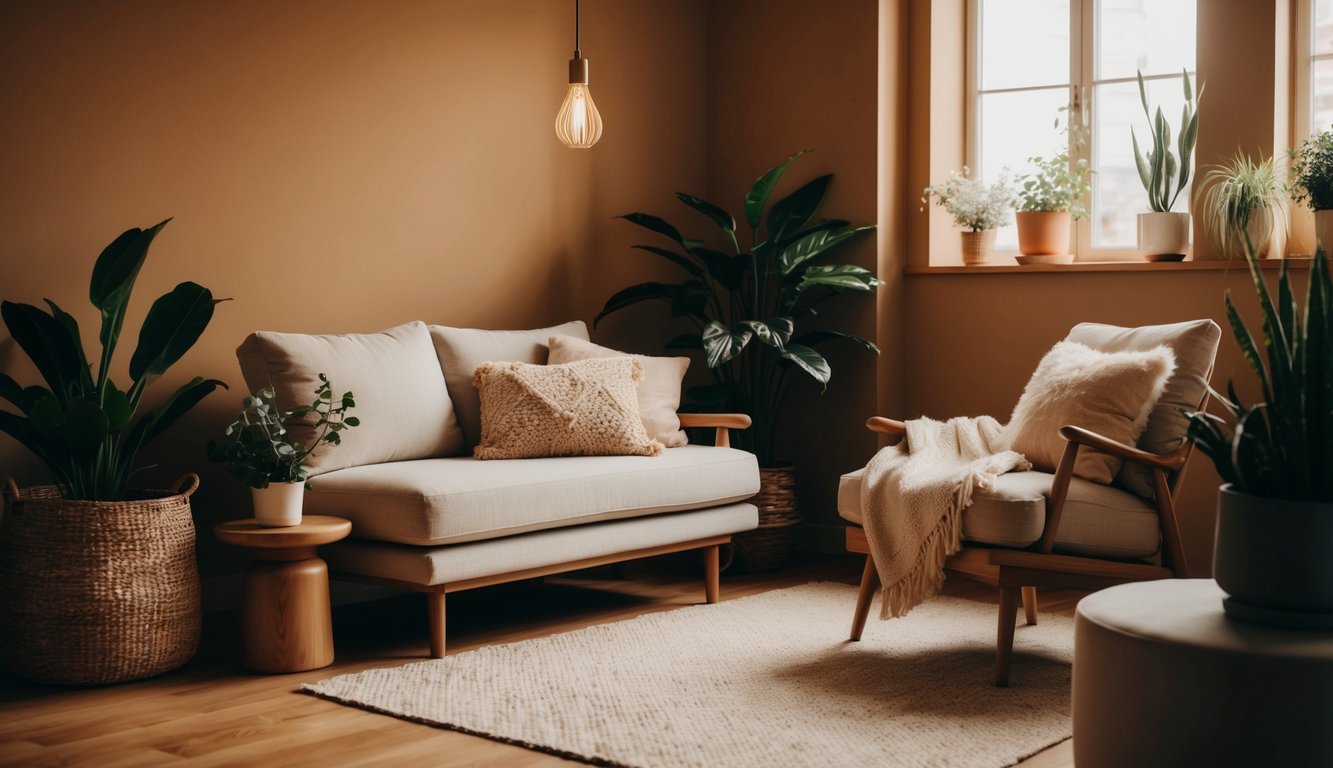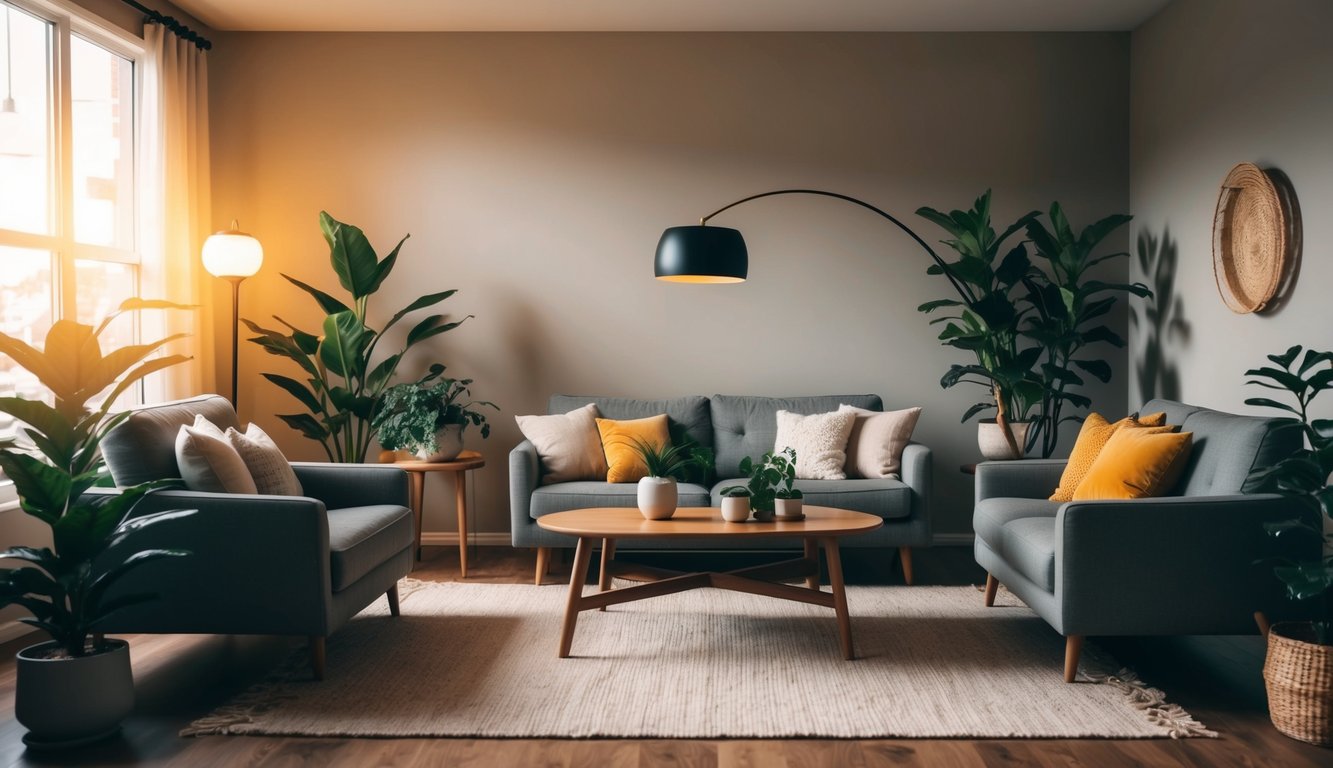Creating a holistic space goes beyond aesthetics. It focuses on designing an environment that nurtures your mind, body, and spirit. Holistic interior design aims to foster well-being by balancing functionality with elements that promote comfort, tranquility, and personal growth. This approach considers every aspect of a room, from color choices to material selection, ensuring each component contributes to a harmonious whole.

By incorporating natural materials, thoughtful lighting, and personalized touches, you can transform your living space into a sanctuary that reflects your values and supports your lifestyle. Whether you’re redesigning a single room or your entire home, embracing holistic design principles can lead to a more balanced and fulfilling living environment.
Key Takeaways
- Holistic design integrates aesthetics, functionality, and well-being to create harmonious spaces
- Natural materials and thoughtful color choices significantly impact the overall feel of a room
- Personalizing your space with meaningful objects enhances its connection to your lifestyle and values
Understanding Holistic Space Design
Holistic space design integrates physical, emotional, and spiritual aspects to create harmonious environments. It focuses on crafting spaces that nurture well-being and promote balance in all areas of life.
The Importance of a Welcoming Environment
A welcoming environment sets the tone for positive experiences and interactions. It can reduce stress, increase comfort, and enhance overall mood. Holistic interior design considers factors like natural light, air quality, and acoustics to create a space that feels inviting.
Color psychology plays a crucial role in setting the right atmosphere. Soft, muted tones can promote relaxation, while vibrant hues can energize a space.
Incorporating natural elements like plants or water features can bring a sense of calm and connection to the outdoors. These elements not only improve air quality but also contribute to a sense of tranquility.
Benefits of a Thoughtfully Designed Space
A thoughtfully designed space can significantly impact your daily life and well-being. It can boost productivity, creativity, and focus in work areas. In living spaces, it can promote relaxation and better sleep quality.
Holistic design also considers the flow of energy in a space, known as feng shui. Proper furniture placement and room layout can enhance this energy flow, leading to a more balanced and harmonious environment.
Personalized elements that reflect your interests and values can create a stronger sense of belonging and comfort in your space. This might include artwork, family photos, or meaningful objects.
Color Psychology in Holistic Spaces

Colors have a profound impact on our emotions, mood, and overall well-being. Understanding and applying color psychology in your holistic space can create a harmonious and nurturing environment that promotes healing and relaxation.
The Impact of Colors on Mood and Healing
Different colors evoke various emotional and physiological responses. Warm colors like red, orange, and yellow can stimulate energy and creativity, making them ideal for social areas. Meanwhile, cool colors such as blue, green, and purple tend to promote calmness and tranquility, perfect for relaxation spaces.
Red can increase heart rate and stimulate appetite, making it suitable for dining areas. Orange enhances enthusiasm and sociability, great for living rooms. Yellow boosts mood and mental clarity, ideal for home offices.
Green is associated with nature and balance, promoting harmony in bedrooms. Blue reduces stress and lowers blood pressure, excellent for bathrooms. Lastly, purple stimulates imagination and spirituality, fitting for meditation spaces.
Choosing the Right Colors for Different Areas
When selecting colors for your holistic space, consider the function of each room. For living areas, use warm tones to create a welcoming atmosphere. In bedrooms, opt for cooler, calming colors to promote restful sleep.
- Living areas: Use warm tones to create a welcoming atmosphere.
- Bedrooms: Opt for cooler, calming colors to promote restful sleep.
- Kitchen: Use energizing yellows or appetizing reds to stimulate conversation and appetite.
- Home office: Choose focus-enhancing blues or creativity-boosting greens.
- Bathroom: Incorporate serene blues or refreshing whites for a spa-like feel.
- Meditation room: Select deep purples or soft greens to encourage introspection and relaxation.
Remember to balance your color choices with neutral tones to avoid overwhelming the senses.
Practical Tips for Incorporating Healing Colors
Start by identifying the primary function of each space and the mood you want to create. Then, use paint, textiles, and decor items to introduce your chosen colors.
- Apply the 60-30-10 rule: 60% dominant color, 30% secondary color, 10% accent color.
- Test paint samples in different lighting conditions before committing.
- Use color accents through pillows, artwork, or rugs for easy changes.
- Incorporate natural elements like plants to enhance the healing properties of green.
- Balance bold colors with neutral tones to create a harmonious atmosphere.
Consider your personal color preferences and how they align with color psychology principles. Tailor your choices to create a space that feels authentically you while promoting well-being and harmony.
Natural Materials and Their Benefits
Natural materials bring warmth, texture, and a sense of connection to the environment into your living spaces. They offer numerous advantages for creating a holistic and welcoming atmosphere in your home.
The Role of Natural Elements in Holistic Design
Natural elements are essential in holistic interior design. They create a harmonious and visually stunning environment that promotes well-being. By incorporating natural materials, you can establish a stronger connection to the outdoors and enhance the overall aesthetic appeal of your space.
Natural materials help ground your living areas and provide a sense of calm. They can improve air quality and create a more relaxed atmosphere in your home. Using elements like wood, stone, and plants can also contribute to better acoustic properties, reducing noise levels and creating a more peaceful environment.
Best Natural Materials to Use
When selecting natural materials for your holistic space, consider the following options:
- Wood: Offers warmth and versatility
- Stone: Provides durability and elegance
- Bamboo: Sustainable and renewable
- Cotton and linen: Breathable and comfortable
- Wool: Insulating and naturally fire-resistant
Incorporating these materials in your furniture, flooring, and decor can create a more inviting and eco-friendly living environment. Natural materials often age beautifully, developing character over time and adding to the unique personality of your space.
Tips for Integrating Natural Materials
To effectively incorporate natural materials into your holistic design, follow these tips:
- Choose a theme that reflects your personal style and desired ambiance.
- Mix textures to create visual interest and depth.
- Use natural light to enhance the beauty of materials like wood and stone.
- Incorporate plants to bring life and purify the air in your space.
- Consider the sustainability and sourcing of materials you choose.
Balance is key when integrating natural elements. Combine different materials to create a cohesive look without overwhelming the space. Remember that small touches, like wooden picture frames or stone coasters, can make a significant impact in your holistic design.
Feng Shui Principles for a Balanced Space
Feng Shui offers powerful tools to create harmony and positive energy in your living spaces. By understanding and applying these principles, you can transform your environment into a nurturing and balanced sanctuary.
Core Concepts of Feng Shui
Feng Shui is based on the idea that your surroundings affect your well-being. The flow of energy, or chi, is central to this practice. You’ll want to ensure chi circulates freely throughout your space.
The concept of yin and yang is crucial. Strive for balance between opposing forces like light and dark, soft and hard, or active and passive areas in your home.
The five elements – wood, fire, earth, metal, and water – play a key role. Incorporate these elements through colors, materials, and shapes to create harmony.
Use the Bagua map to align different areas of your home with specific life aspects like wealth, relationships, or career. This tool helps you focus on enhancing particular areas of your life through intentional design.
Implementing Feng Shui in Your Design
Start by decluttering your space. A tidy environment allows energy to flow more freely. Pay attention to your entryway, as it’s where energy enters your home.
Position furniture to create clear pathways. Avoid placing large pieces directly in line with doors or windows. This promotes positive energy flow throughout your space.
Use colors intentionally. Each hue corresponds to different elements and energies. For example, use earth tones for grounding or blues for calm and tranquility.
Bring in natural elements like plants, water features, and natural light. These can significantly boost the energy in your space. Consider adding a small indoor fountain or strategically placed mirrors to reflect light.
Common Feng Shui Mistakes to Avoid
Avoid placing your bed in line with the door, known as the “coffin position.” This can lead to feelings of vulnerability during sleep. Instead, position your bed so you can see the door without being directly in line with it.
Be cautious with mirror placement. While mirrors can enhance space and light, avoid placing them directly across from your front door or facing your bed.
Don’t overlook the bathroom. Keep toilet lids closed and doors shut to prevent energy from escaping. Consider adding plants or earth elements to balance the water energy.
Avoid clutter under your bed. This can disrupt the flow of energy and affect your sleep quality. Keep this area clear for optimal rest and rejuvenation.
Incorporating Healing Elements

Creating a holistic space involves integrating elements that promote physical, mental, and emotional well-being. By carefully selecting and arranging specific components, you can transform your environment into a sanctuary for healing and relaxation.
The Power of Plants in Holistic Spaces
Plants are essential for creating a holistic healing space at home. They purify the air, reduce stress, and boost mood. Choose low-maintenance options like snake plants, peace lilies, or aloe vera for easy care.
Place plants strategically around your space to maximize their impact. Consider hanging plants to add visual interest and save floor space. Herbs like lavender, rosemary, and basil offer both aesthetic appeal and aromatherapy benefits.
Create a mini indoor garden in a sunny corner to bring nature indoors. Use varying pot sizes and shapes to add depth and texture to your plant display. Remember to water and care for your plants regularly to maintain their health and vitality.
Using Crystals for Energy and Balance
Crystals can enhance the energy of your holistic space. Select crystals based on their properties and your specific needs. Place clear quartz for clarity and amplification, amethyst for relaxation, or rose quartz for love and harmony.
Arrange crystals on shelves, windowsills, or create a dedicated crystal grid. You can also incorporate them into decor by using crystal bookends or geode slices as coasters.
Cleanse your crystals regularly by placing them in sunlight, moonlight, or using sage smoke. This practice helps maintain their energetic properties. Consider wearing crystal jewelry or keeping a small stone in your pocket for continuous energy support throughout the day.
Aromatherapy for a Calming Environment
Aromatherapy is a powerful tool for creating a calming atmosphere in your holistic space. Use essential oils in diffusers to fill your room with soothing scents.
Lavender promotes relaxation, while peppermint can boost energy and focus.
Create custom blends to address specific needs, such as a sleep-promoting mixture of chamomile and vanilla. Place reed diffusers in bathrooms or small spaces for continuous fragrance.
Consider using scented candles or incense for a more traditional approach to aromatherapy. Be mindful of any allergies or sensitivities when selecting scents.
Experiment with different aromas to find what works best for you and your space.
Personalizing Your Space

Creating a holistic space that resonates with you requires thoughtful personalization. Your environment should reflect your unique healing philosophies, cater to specific needs, and strike a balance between function and beauty.
Reflecting Individual Healing Philosophies
Incorporate elements that align with your personal beliefs and practices. If you value meditation, designate a quiet corner with cushions and soft lighting.
For those drawn to aromatherapy, integrate essential oil diffusers throughout your space.
Display meaningful symbols or artwork that inspire you. This could include nature photographs, spiritual artifacts, or motivational quotes.
Choose colors that resonate with your energy – cool blues for calm, vibrant greens for growth.
Consider adding natural elements like plants or a small indoor fountain to connect with nature. These touches not only personalize your space but also contribute to a sense of well-being and grounding.
Customizing for Client Needs
If you’re designing for clients, start with a thorough consultation to understand their specific requirements. Ask about any physical limitations, sensitivities, or preferences they may have.
For those with mobility issues, ensure wide pathways and easily accessible storage. If a client is sensitive to scents, opt for hypoallergenic materials and avoid strong fragrances.
Tailor the lighting to suit individual needs. Some may require bright task lighting, while others prefer softer, ambient options.
Incorporate adjustable fixtures to accommodate different activities and moods throughout the day.
Balancing Functionality and Aesthetics
A holistic space should be both beautiful and practical. Choose furniture that serves multiple purposes, like storage ottomans or fold-out desks, to maximize efficiency without cluttering the area.
Invest in quality pieces that will stand the test of time. This not only reduces waste but also creates a sense of permanence and stability in your environment.
Select materials that feel good to touch and are visually appealing.
Organize your space to promote a natural flow of movement. Keep frequently used items within easy reach and store less essential belongings out of sight.
This creates a clean, calming atmosphere while maintaining functionality.
Conclusion

Creating a holistic space involves thoughtfully combining various elements to promote overall well-being. By focusing on the physical, social, and emotional aspects of your environment, you can transform your living or working area into a nurturing sanctuary.
Remember to incorporate natural elements and personalized decor to enhance comfort and productivity. Pay attention to color psychology and use it to your advantage when designing different rooms.
Consider creating tranquil retreats within your space where you can escape daily pressures and reconnect with yourself. These areas can serve as valuable spots for relaxation and introspection.
Strive for a balance between aesthetics and functionality in your design choices. Each element should contribute to a harmonious environment that supports your physical and emotional well-being.
By implementing these holistic design principles, you can create a space that not only looks appealing but also promotes a sense of calm, productivity, and overall wellness in your daily life.
Frequently Asked Questions

Holistic interior design focuses on creating harmonious spaces that support wellbeing through thoughtful integration of elements. Key principles include using natural materials, optimizing light and airflow, and personalizing spaces to reflect the occupants’ needs and values.
What key factors contribute to a welcoming interior space?
A welcoming interior space incorporates natural elements, comfortable furnishings, and personal touches. Use warm, inviting colors and soft textures to create a cozy atmosphere.
Ensure proper lighting with a mix of ambient, task, and accent lights.
Incorporate plants to bring nature indoors and improve air quality. Display meaningful artwork or family photos to add personality and emotional connection to the space.
Can you give an example of how holistic principles are applied in design?
In a bedroom design, holistic principles might include using organic cotton bedding for comfort and health. Position the bed to maximize natural light exposure in the morning.
Install light-blocking curtains to support quality sleep at night.
Choose calming wall colors like soft blues or greens. Include a small seating area for relaxation and reflection. Use air-purifying plants to improve air quality and add a natural element to the space.
What are the core principles of holistic interior design?
Holistic interior design emphasizes balance, harmony, and connection to nature. It prioritizes the use of non-toxic, sustainable materials to create healthy living environments.
The approach considers the physical, emotional, and spiritual needs of the occupants.
Holistic design integrates feng shui principles to optimize energy flow. It also emphasizes personalization to create spaces that reflect individual values and support personal growth.
How do the various elements of space affect interior design outcomes?
Spatial elements like layout, scale, and proportion significantly impact the functionality and feel of a room. An open floor plan can promote social interaction, while defined zones create a sense of purpose for different areas.
Ceiling height affects perceived spaciousness. Window placement influences natural light and views. Furniture arrangement impacts traffic flow and social dynamics.
Color choices can alter mood and perceived temperature.
What are the best practices for creating a harmonious living environment?
To create a harmonious living environment, start by decluttering and organizing your space. Choose a cohesive color palette that promotes calmness and reflects your personal style.
Incorporate natural materials like wood, stone, and plant fibers.
Ensure proper ventilation and maximize natural light. Create a balance between open areas and cozy nooks.
Use multi-functional furniture to optimize space usage, especially in smaller homes.
How can design elements be integrated to support wellbeing in a space?
Integrate biophilic design elements. Incorporate natural materials, patterns, and views of nature.
Use ergonomic furniture to support physical health and comfort.
Install adjustable lighting systems. These should mimic natural light cycles and support circadian rhythms.
Create dedicated spaces for relaxation and mindfulness practices.
Use sound-absorbing materials to reduce noise pollution.
Choose non-toxic paints and finishes to maintain good indoor air quality.






